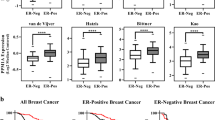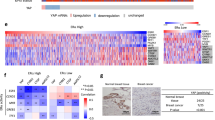Abstract
AP-1 transcription factors play a critical role in signal transduction pathways in many cells. We have investigated the role of AP-1 in controlling proliferative signals in breast cells, and have previously shown that AP-1 complexes are activated by peptide and steroid growth factors in both normal and malignant breast cells. In this study, we investigated the role of AP-1 in transducing proliferative signals induced by peptide and steroid growth factors. We used MCF-7 clones that express a specific inhibitor of AP-1, a dominant-negative cJun mutant (TAM67), under the control of an inducible promoter to investigate the role of AP-1 in regulating breast cancer growth. In the presence of doxycycline (Dox), the AP-1 inhibitor was not expressed, and the MCF-7 clones proliferated normally in response to serum stimulation. However, when Dox was withdrawn, TAM67 was expressed, AP-1 activity was inhibited, and serum-induced proliferation was blocked. We next investigated whether the mitogenic response to specific growth factors also requires AP-1. MCF-7 Tet-Off-TAM67 cells were grown in the presence of increasing concentrations of IGF-1, EGF, heregulin-β, bFGF, or estrogen under un-induced and induced conditions. These studies showed that the AP-1 inhibitor completely blocked proliferation in response to the peptide growth factors (IGF-1, EGF, heregulin-β, and bFGF), and partially blocked the response to estrogen. To investigate the effect of AP-1 blockade on in vivo tumor growth, we injected the MCF-7 Tet-Off TAM67 cells into nude mice receiving doxycycline to suppress the expression of the AP-1 inhibitor. After the mice developed tumors, they were randomized to either continue to receive Dox or not. In mice not receiving Dox, the expression of TAM67 was induced, and tumor growth was inhibited, while the tumors in mice receiving Dox continued to grow. Analysis of the tumors from these mice showed that the expression of TAM67 caused reduced proliferation of the breast cancer cells without inducing apoptosis. These results demonstrate that AP-1 blockade supresses mitogenic signals from multiple different peptide growth factors as well as estrogen, and inhibits the growth of MCF-7 breast cancer cells both in vitro and in vivo. These results suggest that novel agents specifically targeting AP-1 or its activating kinases could be promising agents for the treatment of breast cancer.
This is a preview of subscription content, access via your institution
Access options
Subscribe to this journal
Receive 50 print issues and online access
$259.00 per year
only $5.18 per issue
Buy this article
- Purchase on Springer Link
- Instant access to full article PDF
Prices may be subject to local taxes which are calculated during checkout






Similar content being viewed by others
Abbreviations
- AP-1:
-
activating protein-1
- TAM-67:
-
cJun Dominant-negative mutant
- Dox:
-
doxycycline
- ER:
-
estrogen receptor
- ERE:
-
estrogen response element
- EGF:
-
epidermal growth factor
- IGF:
-
insulin-like growth factor
- TGF-α:
-
transforming growth factor-α
- TPA:
-
12-O-tetradecanoylphorbol-13-acetate
- bFGF:
-
Basic fibroblast growth factor
- HRG-β:
-
Heregulin-beta
References
Allis CD, Gorovsky MA . 1981 Biochemistry 20: 3828–3833
Angel P, Karin M . 1991 Biochemica et Biophysica Acta 1072: 129–157
Bannister AJ, Kouzarides T . 1995 EMBO J. 14: 4758–4762
Baselga J, Mendelsohn J . 1994 Breast Cancer Res. Treat. 29: 127–138
Brown PH, Alani R, Preis LH, Szabo E, Birrer MJ . 1993 Oncogene 8: 877–886
Brown PH, Chen TK, Birrer MJ . 1994 Oncogene 9: 791–799
Chen TK, Smith LM, Gebhardt DK, Birrer MJ, Brown PH . 1996 Mol. Carcinog. 15: 215–226
Claret FX, Hibi M, Dhut S, Toda T, Karin MA . 1996 Nature 383: 453–457
Drebin JA, Link VC, Greene MI . 1988 Oncogene 2: 387–394
Dumont JA, Bitonti AJ, Wallace CD, Baumann RJ, Cashman EA, Cross-Doersen DE . 1996 Cell. Growth Differ. 7: 351–359
Gaub MP, Bellard M, Scheuer I, Chambon P, Sassone-Corsi P . 1990 Cell 63: 1267–1276
Greenberg ME, Ziff EB . 1984 Nature 311: 433–438
Ham J, Babij C, Whitfield J, Pfarr CM, Lallemand D, Yaniv M, Rubin LL . 1995 Neuron 14: 927–939
Harris J, Morrow M, Bodadonna G . 1993 Cancer of the Breast In Cancer: Principles and Practice of Oncology Devita VT, Hellman S and Tosenberg S (eds) Philadelphia: Lippincott Co pp. 1264–1332
Imbra RJ, Karin M . 1987 Mol. Cell. Biol. 7: 1358–1363
Johnson RS, van Lingen B, Papaioannou VE, Spiegelman BM . 1993 Genes Dev. 7: 1309–1317
Johnston SR, Lu B, Scott GK, Kushner PJ, Smith IE, Dowsett M, Benz CC . 1999 Clin. Cancer Res. 5: 251–256
Kovary K, Bravo R . 1991 Mol. Cell. Biol. 11: 4466–4472
Kushner PJ, Agard DA, Greene GL, Scanlan TS, Shiau AK, Uht RM, Webb P . 2000 J. Steroid Biochem. Mol. Biol. 74: 311–317
Liebermann DA, Gregory B, Hoffman B . 1998 Int. J. Oncol. 12: 685–700
Lin F, Xiao D, Kolluri SK, Zhang X . 2000 Cancer Res. 60: 3271–3280
Ludes-Meyers JH, Liu Y, Munoz-Medellin M, Hilsenbeck SG, Brown PH . 2001 Oncogene 20: 2771–2780
Paech K, Webb P, Kuiper GG, Nilsson S, Gustafsson J, Kushner PJ, Scanlan TS . 1997 Science 277: 1508–1510
Paulson JR, Taylor SS . 1982 J. Biol. Chem. 257: 6064–6072
Rapp UR, Troppmair J, Beck T, Birrer MJ . 1994 Oncogene 9: 3493–3498
Riabowol KT, Vosatka RJ, Ziff EB, Lamb NJ, Feramisco JR . 1988 Mol. Cell. Biol. 8: 1670–1676
Sarup JC, Johnson RM, King KL, Fendly BM, Lipari MT, Napier MA, Ullrich A, Shepard HM . 1991 Growth Regul. 1: 72–82
Schiff R, Reddy P, Ahotupa M, Coronado-Heinsohn E, Grim M, Hilsenbeck SG, Lawrence R, Deneke S, Herrera R, Chamness GC, Fuqua SA, Brown PH, Osborne CK . 2000 J. Natl. Cancer Inst. 92: 1926–1934
Schule R, Rangarajan P, Yang N, Kliewer S, Ransone LJ, Bolado J, Verma IM, Evans RM . 1991 Proc. Natl. Acad. Sci. USA. 88: 6092–6096
Smith LM, Wise SC, Hendricks DT, Sabichi AL, Bos T, Reddy P, Brown PH, Birrer MJ . 1999 Oncogene 18: 6063–6070
Umayahara Y, Kawamori R, Watada H, Imano E, Iwama N, Morishima T, Yamasaki Y, Kajimoto Y, Kamada T . 1994 J. Biol. Chem. 269: 16433–16442
Webb P, Lopez GN, Uht RM, Kushner PJ . 1995 Mol. Endocrinol. 9: 443–456
Webb P, Nguyen P, Valentine C, Lopez GN, Kwok GR, McInerney E, Katzenellenbogen BS, Enmark E, Gustafsson JA, Nilsson S, Kushner PJ . 1999 Mol. Endocrinol. 13: 1672–1685
Yang L, Kim HT, Munoz-Medellin D, Reddy P, Brown PH . 1997 Cancer Res. 57: 4652–4661
Acknowledgements
We thank Drs Steffi Oesterreich, Adrian Lee, and Kendall Wu for their helpful discussions and critical reading of the manuscript, Drs Craig Allred and Syed Mohsin for their assistance with preparation of the figures, and Ms Linda Kimbrough for her assistance in preparing the manuscript. This work was supported by the Department of Defense grant (DAMD-17-96-1-6225 to PH Brown), the Department of Defense Postdoctoral Fellowship Award (BC-000322 to Y Liu), and the National Institutes of Health Specialized Programs of Research Excellence (SPORE) grant (CA 58183 to CK Osborne.)
Author information
Authors and Affiliations
Corresponding author
Rights and permissions
About this article
Cite this article
Liu, Y., Ludes-Meyers, J., Zhang, Y. et al. Inhibition of AP-1 transcription factor causes blockade of multiple signal transduction pathways and inhibits breast cancer growth. Oncogene 21, 7680–7689 (2002). https://doi.org/10.1038/sj.onc.1205883
Received:
Revised:
Accepted:
Published:
Issue Date:
DOI: https://doi.org/10.1038/sj.onc.1205883
Keywords
This article is cited by
-
Ras association domain family member 10 suppresses gastric cancer growth by cooperating with GSTP1 to regulate JNK/c-Jun/AP-1 pathway
Oncogene (2016)
-
Cell-composition effects in the analysis of DNA methylation array data: a mathematical perspective
BMC Bioinformatics (2015)
-
Elevated DDX21 regulates c-Jun activity and rRNA processing in human breast cancers
Breast Cancer Research (2014)
-
Increased phosphorylation of histone H3 at serine 10 is involved in Epstein-Barr virus latent membrane protein-1-induced carcinogenesis of nasopharyngeal carcinoma
BMC Cancer (2013)
-
FAT1 acts as an upstream regulator of oncogenic and inflammatory pathways, via PDCD4, in glioma cells
Oncogene (2013)



